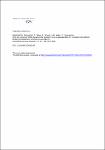Only the complex N559-glycan in SV2C mediates high affinity binding to botulinum neurotoxin serotype A1
Mahrhold, Stefan
Bergström, Tomas
Stern, Daniel
Dorner, Brigitte
Astot, Crister
Rummel, Andreas
The extraordinary potency of botulinum neurotoxins (BoNTs) is mediated by their high neurospecificity, targeting peripheral cholinergic motoneurons leading to flaccid paralysis and successive respiratory failure. Complex polysialo gangliosides accumulate BoNTs on the plasma membrane and facilitate subsequent binding to synaptic vesicle membrane proteins which results in toxin endocytosis. The luminal domain 4 (LD4) of the three synaptic vesicle glycoprotein 2 (SV2) isoforms A-C mediates uptake of the clinically most relevant serotype BoNT/A. SV2C-LD4 exhibits the strongest protein-protein interaction and comprises five putative N‑glycosylation sites. Here, we expressed human SV2C‑LD4 fused to human IgG‑Fc in prokaryotic and eukaryotic expression systems to analyse the effect of N‑glycosylation of SV2C on the interaction with BoNT/A. Mass spectrometric analysis of gSV2CLD-Fc demonstrates glycosylation of N534, N559 and N565, the latter two residing at the BoNT/A interface. Mutational analysis exhibits that only the N559‑glycan, but not N565-glycan increases affinity of BoNT/A to human gSV2C‑LD4. The N559‑glycan was characterised as of complex core-fucosylated type with a heterogeneity ranging up to tetra-antennary structure with bisecting N‑acetylglucosamine which can establish extensive interactions with BoNT/A. The mutant gSV2CLD-Fc N559A displayed a 50-fold increased dissociation rate k d resulting in an overall 12-fold decreased binding affinity in surface plasmon resonance experiments. The delayed dissociation might provide BoNT/A more time for endocytosis into synaptic vesicles. In conclusion, we show the importance of the complex N559‑glycan of SV2C-LD4, adding a third anchor point beside a ganglioside and the SV2C-LD4 peptide, for BoNT/A neuronal cell surface binding and uptake.
Notes
‘European Union (EU)’ and ‘Horizon 2020’
No license information

